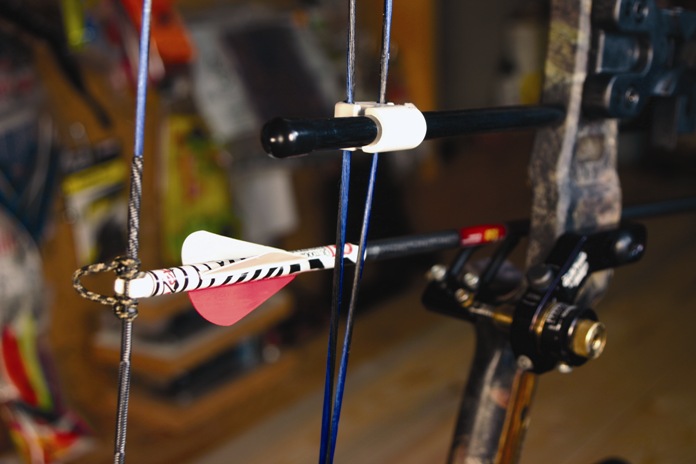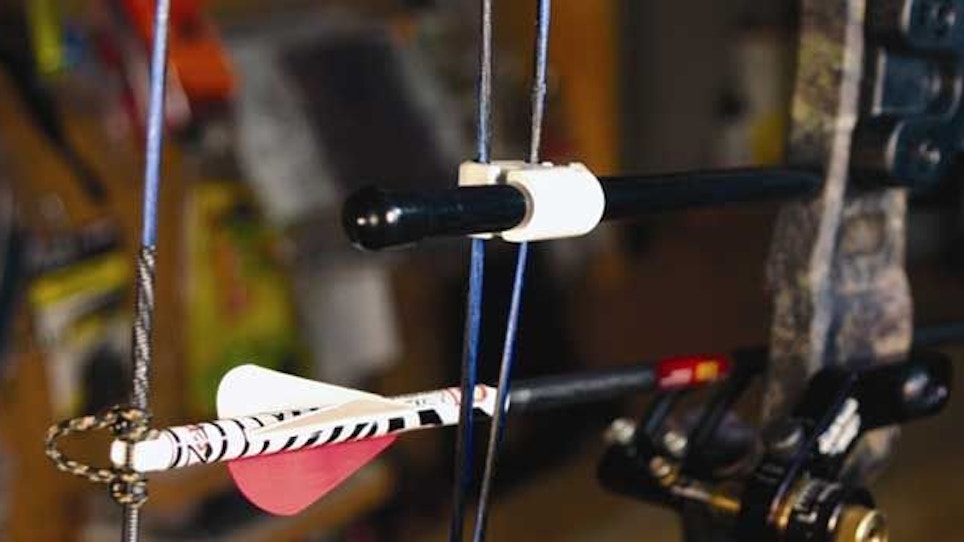Previously: Vanes & Feathers, Pros & Cons
 Factor In Broadheads
Factor In Broadheads
For those of us shooting compound bows with release aids, which fletching is best depends upon the other setup components, especially the rest and the broadhead. Let’s look first at broadheads. Conventional wisdom has said that larger, fixed-blade broadheads require larger fletching with more helical while mechanical, or open-on-impact heads, require less. The better mechanical heads do, indeed, fly like field points. Mechanical heads have improved, and more than a few claim penetration equal or superior to that of conventional heads. Some manufacturers also tout design changes that insure good penetration on sharply angled hits. Bowhunters who select good ones can achieve the arrow control they need with smaller vanes and minimal helical or offset.
Still, many bowhunters prefer fixed-blade broadheads, if not for every hunting application, at least for some. I know a few guides who strongly discourage their clients from using mechanical heads; the larger or more potentially dangerous the game, the stronger their feelings. For hunters shooting fixed-blade heads, stabilization becomes an issue. Some heads of the same size fly better than other heads of the same size. Unfortunately there is no simple formula that will tell us how big the fletching and how great the helical or offset must be for proper stabilization. As I discovered with those 2-inch Bohning Blazers, it’s not all about size.
How does a 2-inch vane stabilize a broadhead once thought to require 4-inch fletching or more? Stiffness is one way. A stiffer vane provides better stabilization than does a softer vane. The stiffer vane may offer some additional advantages as well. It might be more durable, for instance. Though it will not flatten out to reduce contact problems the way feathers will, the shorter vane does reduce contact problems somewhat. Since it is shorter, it can be fletched with a somewhat larger degree of helical or offset and be less likely to contact a rest than longer fletching will. Stiffer vanes might also be less noisy in flight. Softer vanes can ripple in flight, which makes them noisy and reduces their ability to stabilize broadhead-tipped arrows.
Stiffness is one way to achieve a faster spin rate for greater stabilization, but not the only way. Several fletching styles employ some form of wings or tabs to accomplish the same thing. Probably the best known among these is NAP’s QuikSpin vanes, which make use of a tab on one side and grooves in the other side of the vane. For many setups, they do tend to produce tighter groups with broadheads.
Rest Styles & Fletching Contact
The broadhead alone won’t necessary enable a bowhunter to choose the fletching that is best for his setup. The rest, too, is a critical factor in the equation. Relatively skinny carbon arrows with shoot-through rests make fletching choices critical. Feather fletching can help reduce problems caused by contact, but far better still is to eliminate the contact. A high degree of helical or offset—6 percent or more, for instance—will in many cases result in contact. Many setups use 4-inch vanes with a helical of 2 percent or less. The only way to determine if that is adequate with a given broadhead is trial and error. Bowhunters can increase helical or offset, at least slightly, using shorter vanes. In my experience, the shorter, stiffer vanes with more helical stabilize a given arrow at least as well as or, in some cases, better than the longer, softer vanes. Again, the only way to know for sure is to experiment. Shorter vanes also reduce weight enough to increase speed by as much as two or three feet per second.
Apart from making vanes shorter, another way to reduce contact problems is with lower-profile vanes, such as those offered by Duravanes and some other manufacturers. Some of these are proportionately longer to offer the same surface area as shorter-, but higher-profile vanes, while others, like the super-short vanes, provide control with added stiffness.
Containment-style rests can also reduce contact problems, regardless of the type and size of fletching used. On many such rests, the arrow is supported underneath on two points, with a third point above to contain and “guide” the arrow. These tend to be forgiving of most fletching types. Whisker Biscuit rests do well with a variety of fletching styles, too, but the vanes made of rubber or any softer synthetic may wear quickly. Harder, stiffer synthetic vanes (usually urethane) tend to show some initial wear, which then stops without affecting performance.
Finally, drop-away rests leaves bowhunters free to use virtually any kind of fletching that achieves adequate stability. Hunters using drop-aways can forget contact issues and focus entirely on other priorities, such as speed, silence, or durability.
Ultimately, selecting the best fletching for a given setup requires considering the broadhead (or at least the style of broadhead) that will be used with the rest. In the past, some bowhunters, to minimize contact problems and gain speed with less weight, used the smallest fletching that would stabilize their arrows. Others, to insure the best arrow flight with fixed-blade broadheads, leaned toward using the largest fletching with the greatest helical that would not cause contact problems. As we’ve seen, the wide selection of broadheads, rests, and fletching styles now available have made that a false choice. Some broadheads require little in the way of extra stabilization. Some rests minimize (and perhaps eliminate) contact problems. And, some very small vanes may stabilize arrows as well as significantly larger vanes of a few years ago.






